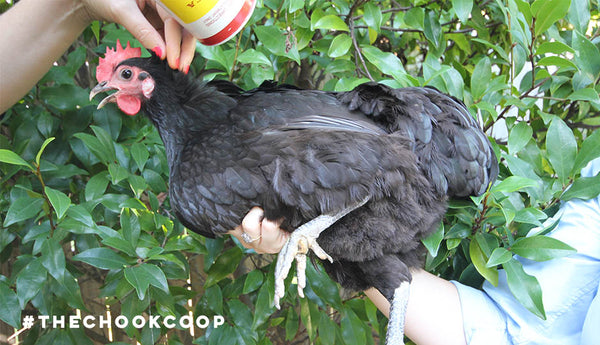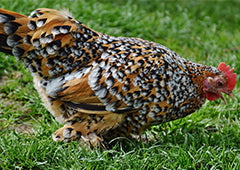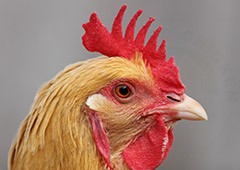What is Fowl Pox?
The Foul Symptoms of Fowl Pox
A chicken infected with Fowl Pox will be quieter than usual, may eat less and may show symptoms of respiratory illness. Typical symptoms of illness, right? Yes, but a few days later the defining symptoms of Fowl Pox will present themselves- lesions. Lesions will begin to form on any non-feathered areas of a chicken’s body.
Fowl Pox appears in two distinct forms:
The Dry Form: Chickens affected with the dry form of Fowl Pox will develop small bumps or raised areas which eventually pop open and secrete pus which hardens into a crusty scab. As mentioned previously, these lesions occur on any non-feathered areas such as combs, wattles, beaks, eyes, earlobes, and legs. Your poor infected chooks will feel pain and irritation. The impact of this virus may cause secondary side effects of weight loss and a decrease in egg laying. Lesions occurring on a chicken’s eyelid may cause such discomfort that a bird may find it difficult to open their eyes. The dry form is the milder form of the two and usually does not end in death.
The Wet Form: Chickens affected with the wet form of Fowl Pox will also develop lesions. These lesions will typically affect the inside of an infected bird’s mouth, throat and trachea or on the conjunctiva of a bird’s eye. A chicken’s trachea may appear reddened and inflamed. The wet form is the more serious form of the two due to the fact that as the lesions grow and develop they may block air coming into the trachea causing suffocation. Also, birds may not be able to eat or drink causing eventual death.
Fowl Pox can often begin as the wet form and spread as the dry form and vice versa. Also, this virus can appear in both forms simultaneously.
The duration of the Fowl Pox virus is approximately 10 – 14 days; however, if an entire backyard flock is infected, the duration can extend for several more weeks. Most chickens will be immune following recovery period. A small percentage though will remain carriers and succumb to the virus when feeling stressed.
How is Fowl Pox Transmitted?
This insidious infection enters a chicken’s body through simple scratches or open wounds and through the mucous membranes of the bird’s eyes and mouth.
There are several ways in which this disease can be spread. Infected chickens can spread their germs in two ways. First, they can shed pox particles onto their siblings or into their coop environment and secondly, if a bird is infected with the wet form of Fowl Pox, they can spread germs through secretions.
Or, carrier insects, especially mosquitoes, will bite your unsuspecting chooks and infect them with the virus. Flies simply walking around on your precious chooks can leave behind virus germs.
Since the Fowl Pox virus is found worldwide, all backyard chicken keepers need to be on the lookout for telltale signs. If you travel and visit family or friends who have either chickens or turkeys or both or if you are involved in showing your birds, you will need to be extremely cautious and practice good biosecurity by washing hands before and after handling poultry, changing clothes and shoes after handling other’s birds, etc.
Diagnosing Fowl Pox
The dry form of Fowl Pox can be diagnosed easily enough due to the highly recognizable crusty scabs; however, the wet form of this disease can pose difficulty as the symptoms mimic those of other respiratory illnesses. Microscopic analysis of your chook’s skin cells is needed to ascertain a definite diagnosis of the wet form.
It’s Fowl Pox! Now What?
If you suspect that one or several of your chooks have contracted the Fowl Pox virus, don’t be alarmed. This is a very slow spreading virus and you do have time to isolate the infected birds and tend to them without them wreaking germ havoc throughout your entire flock. If however your whole flock is feeling under the weather and breaking out in lesions, simply treat the entire flock.
Due to the fact that secondary respiratory infections are common once chickens have been infected with the Fowl Pox virus, it’s a good idea to seek help from your veterinarian. The veterinarian can prescribe antibiotics to prevent any further infections.
Prevent, Prevent, Prevent
Prevention is always the best medicine! Preventing Fowl Pox from infecting your backyard flock can be as simple as being proactive and maintaining good biosecurity- being sure to isolate new flock members for a period of no less than 30 days, keeping birds in their home coop and avoiding showing them, not visiting friend’s and neighbor’s flocks and vice versa and doing all you can to wage war on any insect pests that may prey on your unsuspecting feathered friends.
Good news is at hand though- by planting insect repelling plants near and around your chicken coop and run you can come to the aid of your beloved chooks and help fight the war against the foul Fowl Pox!
Simply plant some popular Australian Pennyroyal and keep disease carrying mosquitoes and flies away from your chicken coop. All natural prevention is yours for the planting- plant some Basil, Catnip, Marigolds, Peppermint, Rosemary and Thyme that will not only repel annoying insect pests, but will add a little beauty and scent-sational scents for you to enjoy while tending your fine feathered flock. Yay!
Vaccinations to prevent the infamous Fowl Pox are readily available. However, vaccinations must be administered at specific time periods- vaccinate chicks as early as one day old (the Fowl Pox vaccine can be combined with the Marek’s Disease vaccine often given to day old chicks), then vaccinate again after your birds have reached 8 – 10 weeks of age.
A good rule of thumb in preventing this virus is to regularly check your flock for scratches and open wounds. Treat any abnormalities that you find to keep this dreaded virus from infecting your chooks.
Adding probiotics to your chicken feed is another great way to boost your precious chook’s immune system, thus helping them to better arm themselves against illnesses in general.
Treatment for Fowl Pox
Unfortunately, there is no known cure for the Fowl Pox virus. Fortunately the same vaccination given to prevent the disease can also be administered to aid in lessening the spread of the virus, but only in flocks where up to twenty percent of the flock has been infected.
There are several things you can do to ease your flock’s discomfort during an outbreak- keep birds comfortable, limit stress, and apply antiseptic to scabs. It’s also helpful to remove any scabs around their eyes and mouth to help them to eat and drink more easily.
A special diet, originally created to aid birds afflicted with Ricketts, can also help chickens infected with Fowl Pox, as well as, aid in the recuperation of sick birds in general.
The Ricketts Diet
1 Large Egg Yolk cooked and crumbled
1 Teaspoon Cod Liver Oil
2 Tablespoons Sugar-free Yogurt
2 – 4 Tablespoons Oats
2 Tablespoons of Apple (grated)
2 Tablespoons of Canned Beef cat food
A small drizzle of honey
Some Avian Multi-vitamin powder (see instructions for individual brands)
Feed this concoction to sick birds once a day for as long as needed. If however, it’s not completely consumed each day, throw out the leftovers and make up a new batch for the next day.
Moving On From Fowl Pox
Following an outbreak, always thoroughly clean and disinfect your chicken coop. Be sure to dispose of any scab debris in the coop and run because due to the fact that Fowl Pox is a very resistant virus, its germs can live for extended periods on any scabs that have fallen off your birds.
Once your flock has fully recuperated, be vigilant about regular flock “check- ups”. Be on the lookout for any small scratches that could become a breeding ground for the Fowl Pox virus.
Feel free to lavish attention on your fine feathered friends! They deserve it. Treat your chooks to some of their favorite treats and sit back and relax as normalcy returns once more to your chicken coop!
If you want to know more about different types of chicken diseases and illnesses, like diarrhoea and avian leukosis, our Learning Centre is full of useful articles.

















